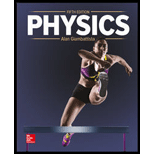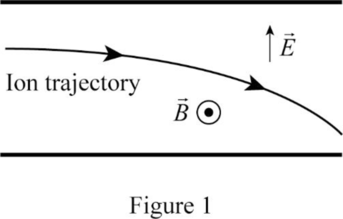
Concept explainers
(a)
The speed with which the
(a)
Answer to Problem 128P
The speed with which the
Explanation of Solution
The kinetic energy gained by the ion must be equal to the potential energy lost.
Write the equation for the conservation of energy.
Here,
Write the equation for
Here,
Write the equation for
Here,
Put equations (II) and (III) in equation (I).
Here,
Write the relation for the speed of
Here,
Write the relation for the speed of
Here,
Take the ratio of the above two equations.
Conclusion:
The charge of the ion
Substitute
Therefore, the speed with which the
(b)
The sketch of the trajectory of
(b)
Answer to Problem 128P
The sketch of the trajectory of

Explanation of Solution
In a velocity selector, for an ion with speed
Write the equation for the magnetic force.
Here,
In the velocity selector,

Conclusion:
Thus, the sketch of the
(c)
The diameter of the path of
(c)
Answer to Problem 128P
The diameter of the path of
Explanation of Solution
Write the equation for the magnitude of the magnetic force on ions using equation (V).
Here,
The magnetic force provides the
Write the relationship between the magnetic force and the centripetal force.
Here,
Write the equation for the magnitude of the centripetal force on ions.
Here,
Write the equation for the radius of a circle.
Here,
Put the above equation in equation (VIII).
Put equations (VI) and (IX) in equation (VII).
Since
Write the relationship between the diameters of the paths of
Here,
Rewrite the above relationship for
Conclusion:
Substitute
Therefore, the diameter of the path of
Want to see more full solutions like this?
Chapter 19 Solutions
Physics
- (a) At what speed will a proton move in a circular path of the same radius as the electron in the previous exercise? (b) What would the radius of the path be if tlie proton had the same speed as the election? (c) What would the radius be if the proton had tlie same kinetic energy' as die electron? (d) The same momentum?arrow_forwardA Van de Graaff accelerator utilizes a 50.0 MV potential difference to accelerate charged particles such as protons. (a) What is the velocity of a proton accelerated by such a potential? (b) An electron?arrow_forwardThe magnetic field in a cyclotron is 1.25 T, and the maximum orbital radius of the circulating protons is 0.40 m. (a) What is the kinetic energy of the protons when they are ejected from the cyclotron? (b) What Is this energy in MeV? (c) Through what potential difference would a proton have to be accelerated to acquire this kinetic energy? (d) What is the period of tire voltage source used to accelerate the piotons? (e) Repeat tire calculations for alpha-particles.arrow_forward
- Certain sharks can detect an electric field as weak as 1.0 μV/mμV/m. To grasp how weak this field is, if you wanted to produce it between two parallel metal plates by connecting an ordinary 1.5 VV AA battery across these plates, how far apart would the plates have to be? Express your answer in meters.arrow_forwardAn evacuated tube uses an accelerating voltage of 2.1 kV to accelerate a beam of electrons that hit a copper plate and generate x-rays. What if the maximum (non-relativistic) velocíty of the electrons?arrow_forwardTwo large parallel plates are placed horizontally with respect to each other and are then connected to a 200V battery. If the distance beteeen the plates is 2cm, the uniform electric field between the plates is 10^4N/C in the upward direction. If the electron is released from rest at the upper plate, calculate: a) the kinetic energy of the electron after traveling 2cm to the lower plate. b) the time required for the electron to travel this distance.arrow_forward
- A proton is fired with a speed of vi=178260.0m/s from the midpoint of the capacitor shown towards the positive plate. If V2=590.0V, What is the proton's speed as it collides with the negative plate?arrow_forwardA small charged particle of mass 1.0 x 10-8 kg is traveling rightward between two plates separated by a distance d = 80 cm, as shown below. The electric field between the plates has a constant magnitude of 3.0 x 106 V/m and is directed leftward. The particle's speed is 5.0 x 103 m/s at the left plate and 2.0 x 10³ m/s at the right plate. Ignore the effect of gravity. F (a) Is the particle positively charged or negatively charged? Justify your answer briefly but clearly. (b) Find the charge (with correct sign) of the particle, as well as the potential difference (with correct sign) through which the particle has moved. (Note: The potential difference is positive if the right plate is at a higher potential than the left plate, and negative if the right plate is at a lower potential than the left plate. Show all your work; do not simply plug numbers into a result derived in class.)arrow_forwardAn Alpha particle ( a Helium nucleus with a +2e charge) enters a parallel plate arrangement through a hole in the positive plate held at +5.0V and is accelerated towards the negative plate held at -5.0V. a) What is speed of the Alpha particle when it reaches the negative plate? (Assume its initial velocity is zero) b) How fast is it moving when it is at the center of the gap between the plates? Mass of Alpha Particle: m = 6.645 × 10-27kg a Elementary charge: e = 1.602× 10-19Carrow_forward
- Question 1 a) In J. J. Thomson experiment (1897), an electron moving horizontally with a constant speed vo enters in between the horizontal plates of a capacitor. The electric field strength between the plates of length L and distance d, is E. The vertical deviation of the electron at the moment of exit from the field region is measured to be Y. Derive the expression giving the electron's charge to mass ratio, i.e. e/m to be 2v,Y/CEL). (Recall that Thomson received Nobel Prize for his achievement.) b) Calculate e/m, knowing the following data. E=1.6x10* Newton/Coulomb, L=10 cm, Y=2.9 cm, v=2.19x10* km/s. (Be careful to use coherent units.)arrow_forwardA +5.6 C charged particle (m=2.0 kg) is placed 42 cm from a -3.7C stationary charge. If the particle starts from rest, how fast will it moving after it has traveled 24.0 cm. What is the change in potential energy, and what is the speed of the particle?arrow_forward(a) An positron (electron with a positive charge) starts at rest and accelerates through an electric field established by a set of parallel plates with a potential difference of 35 V. What is the speed of the positron the instant before it hits the negative plate?(e = 1.6 × 10-19 C, melectron = 9.1 × 10-31 kg) (b) Instead of hitting the negative plate, the positron, travelling East, escapes the parallel plates through a small hole and enters a magnetic field of 0.75 T directed downward. What will be the magnetic force (magnitude and direction) on the charge?(c) Once the positron has entered the magnetic field, it is in circular motion. What is the radius of the positron's circular path?arrow_forward
 Physics for Scientists and Engineers with Modern ...PhysicsISBN:9781337553292Author:Raymond A. Serway, John W. JewettPublisher:Cengage Learning
Physics for Scientists and Engineers with Modern ...PhysicsISBN:9781337553292Author:Raymond A. Serway, John W. JewettPublisher:Cengage Learning Physics for Scientists and EngineersPhysicsISBN:9781337553278Author:Raymond A. Serway, John W. JewettPublisher:Cengage Learning
Physics for Scientists and EngineersPhysicsISBN:9781337553278Author:Raymond A. Serway, John W. JewettPublisher:Cengage Learning Principles of Physics: A Calculus-Based TextPhysicsISBN:9781133104261Author:Raymond A. Serway, John W. JewettPublisher:Cengage Learning
Principles of Physics: A Calculus-Based TextPhysicsISBN:9781133104261Author:Raymond A. Serway, John W. JewettPublisher:Cengage Learning
 College PhysicsPhysicsISBN:9781938168000Author:Paul Peter Urone, Roger HinrichsPublisher:OpenStax College
College PhysicsPhysicsISBN:9781938168000Author:Paul Peter Urone, Roger HinrichsPublisher:OpenStax College




